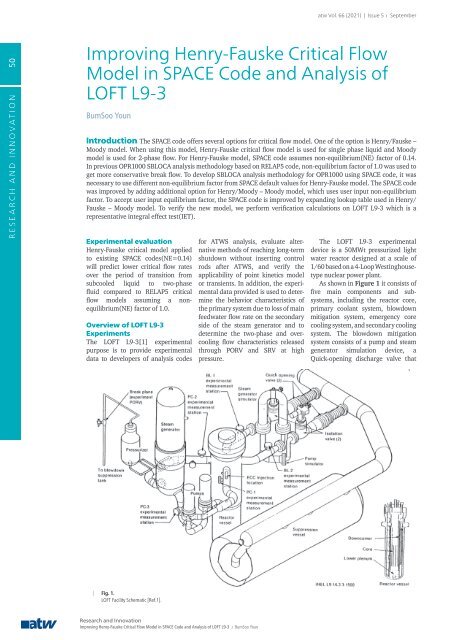atw - International Journal for Nuclear Power | 05.2021
Description Ever since its first issue in 1956, the atw – International Journal for Nuclear Power has been a publisher of specialist articles, background reports, interviews and news about developments and trends from all important sectors of nuclear energy, nuclear technology and the energy industry. Internationally current and competent, the professional journal atw is a valuable source of information. www.nucmag.com
Description
Ever since its first issue in 1956, the atw – International Journal for Nuclear Power has been a publisher of specialist articles, background reports, interviews and news about developments and trends from all important sectors of nuclear energy, nuclear technology and the energy industry. Internationally current and competent, the professional journal atw is a valuable source of information.
www.nucmag.com
Create successful ePaper yourself
Turn your PDF publications into a flip-book with our unique Google optimized e-Paper software.
<strong>atw</strong> Vol. 66 (2021) | Issue 5 ı September<br />
50<br />
RESEARCH AND INNOVATION<br />
Improving Henry-Fauske Critical Flow<br />
Model in SPACE Code and Analysis of<br />
LOFT L9-3<br />
BumSoo Youn<br />
Introduction The SPACE code offers several options <strong>for</strong> critical flow model. One of the option is Henry/Fauske –<br />
Moody model. When using this model, Henry-Fauske critical flow model is used <strong>for</strong> single phase liquid and Moody<br />
model is used <strong>for</strong> 2-phase flow. For Henry-Fauske model, SPACE code assumes non-equilibrium(NE) factor of 0.14.<br />
In previous OPR1000 SBLOCA analysis methodology based on RELAP5 code, non-equilibrium factor of 1.0 was used to<br />
get more conservative break flow. To develop SBLOCA analysis methodology <strong>for</strong> OPR1000 using SPACE code, it was<br />
necessary to use different non-equilibrium factor from SPACE default values <strong>for</strong> Henry-Fauske model. The SPACE code<br />
was improved by adding additional option <strong>for</strong> Henry/Moody – Moody model, which uses user input non-equilibrium<br />
factor. To accept user input equilibrium factor, the SPACE code is improved by expanding lookup table used in Henry/<br />
Fauske – Moody model. To verify the new model, we per<strong>for</strong>m verification calculations on LOFT L9-3 which is a<br />
representative integral effect test(IET).<br />
Experimental evaluation<br />
Henry-Fauske critical model applied<br />
to existing SPACE codes(NE=0.14)<br />
will predict lower critical flow rates<br />
over the period of transition from<br />
subcooled liquid to two-phase<br />
fluid compared to RELAP5 critical<br />
flow models assuming a nonequilibrium(NE)<br />
factor of 1.0.<br />
Overview of LOFT L9-3<br />
Experiments<br />
The LOFT L9-3[1] experimental<br />
purpose is to provide experimental<br />
data to developers of analysis codes<br />
<strong>for</strong> ATWS analysis, evaluate alternative<br />
methods of reaching long-term<br />
shutdown without inserting control<br />
rods after ATWS, and verify the<br />
applicability of point kinetics model<br />
or transients. In addition, the experimental<br />
data provided is used to determine<br />
the behavior characteristics of<br />
the primary system due to loss of main<br />
feedwater flow rate on the secondary<br />
side of the steam generator and to<br />
determine the two-phase and overcooling<br />
flow characteristics released<br />
through PORV and SRV at high<br />
pressure.<br />
The LOFT L9-3 experimental<br />
device is a 50MWt pressurized light<br />
water reactor designed at a scale of<br />
1/60 based on a 4-Loop Westinghousetype<br />
nuclear power plant.<br />
As shown in Figure 1 it consists of<br />
five main components and subsystems,<br />
including the reactor core,<br />
primary coolant system, blowdown<br />
mitigation system, emergency core<br />
cooling system, and secondary cooling<br />
system. The blowdown mitigation<br />
system consists of a pump and steam<br />
generator simulation device, a<br />
Quick-opening discharge valve that<br />
| Fig. 1.<br />
LOFT Facility Schematic [Ref.1].<br />
Research and Innovation<br />
Improving Henry-Fauske Critical Flow Model in SPACE Code and Analysis of LOFT L9-3 ı BumSoo Youn

















